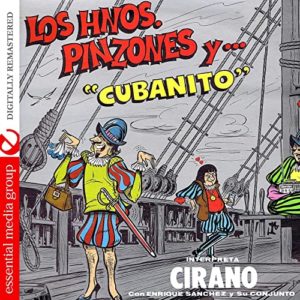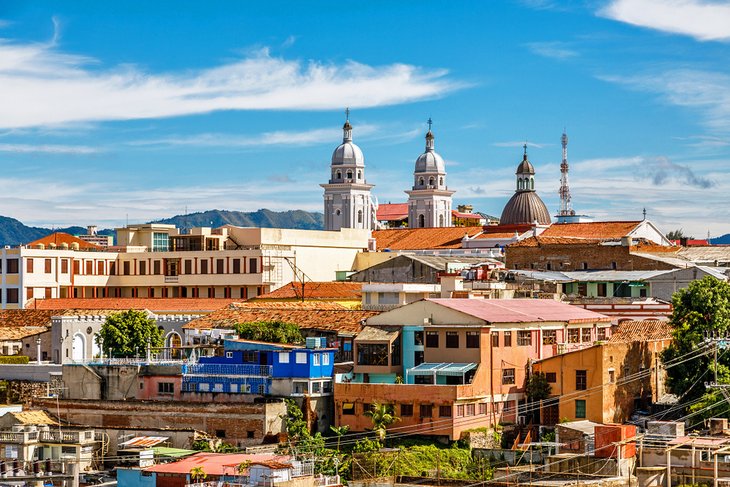THE HUMORISTICS “LOS CASANOVAS”, “LOS TADEOS” AND THE “BROTHERS PINZONES”. VIDEOS
In a country where mockery, sarcasm, satire, choteo, in short, some of the different types of humor, are more every day than the scrawny, sour, hairy, and greenish bread of ours every day, the authorities twitch and They wage war on a minimal or colossal joke that will unleash laughter.
ARTISTIC CAREER
The Casanovas, called that way in the beginning, and later in their career became Los Tadeos, were a duo of singers, comedians, and fonomímicos. Made up of guitarist Alfonso Casanova and double bass player Armando Argüelles “El Gordo”.
They were very successful from the late 1950s in Cuba and after 1960 throughout Latin America. Besides singing they made imitations and jokes.
This humorous-musical duo was still heard in Cuba in the early years of the 1960s. Los Tadeos sang ‘Los Hermanos Pinzones’, ‘Cubanito’ and numbers like that, spicy for the moral canons of the time, but comical if you want to be rather naive.
https://youtu.be/PLgcxTvf-1U
LOS HERMANOS PINZONES (VIDEOS)
On the radio they could hear what became their smash hit, ‘El gago billetero’. If my memories are not confused, they sang it live on the ‘Tota y Pepe’ program (which would later become ‘Rita y Paco’, on Alegrías de Sobremesa).
The Tadeos interspersed jokes and humorous comments in the songs they interpreted. They stopped the music and there that goes. They were free, spontaneous, and original. They came from before, they triumphed because of their competitive talent and they owed nothing to the Castro revolution.
LOS TADEOS ENTER CUBAN POLITICS
The shortages in Cuba since the 60s begin essential products and their prices to fall in a spiral. Everything was missing, from meat to viands, chicken, rice and even sugar and coffee. The black bag was shot in an arrow in the middle of the famine and the hardships. And the regime did not come up with any other solution than to decree free funerals. Dying no longer cost anything on the island of the living dead.
The Thaddeans, who normally did not enter politics, could not hold out. They reacted with ghoulish humor live and direct. Some say it was on television; others, that in the Red Room of the Hotel Capri, although I believe, without being able to assure it in a reliable way, that it happened in the program of Tota y Pepe, of Radio Progreso. I was a child at the time, but I remember well the laughter of the elders. Los Tadeos’ number rang from San Antonio to Maisí. It was not for less.
https://youtu.be/i3zTZ7QGG3M
LOS TADEOS SING “EL GAGO BILLETERO” (VIDEOS)
“What is the height of a ruler?” Asked one Thaddeus and the other replied: “Kill a people from hunger and pay for their burial.” Needless to say, that was the last performance of the duo Los Tadeos. They disappeared. They went off the air forever.
In the 1960s, the humorous duo Los Tadeos was expelled from Cuban television and sentenced to ostracism or exile for the simple crime of asking on a live program: What is the height of a president? And answer: Kill a people of hunger and make their burial free.
When Armando retired he settled in Miami dedicated to business, and Alfonso, who was the one who wrote the librettos, moved to Puerto Rico forming a couple with the humorist Henry Lafont, without the musical ingredient, only with jokes.
Armando Argüelles “El Gordo” later joined Rodolfo Romero “El Tadeo” when he arrived in Miami from Spain and formed the
new Duet Los Tadeo.
As a Cuban immigrant living in Miami, the comedian El Tadeo became something of a popular hero. His monologues full of black humor and double meaning were quite popular with his fellow immigrants, and he became a popular attraction in the clubs of Little Havana and Hialeah.
These very special and historically significant recordings stand as a document of his unique talent and offer a glimpse into the culture and customs of the Cuban population living in Miami at the time.
In the first months of the 80s, Rodolfo “El Tadeo” died in Miami.
HUMORISTISTAS “LOS CASANOVAS”, “LOS TADEOS” Y LOS “HERMANOS PINZONES”
En un país donde la burla, el sarcasmo, la sátira, el choteo, en fin, algunos de los diferentes tipos de humor, son más cotidianos que los esmirriados, ácidos, peludos y verdosos panes nuestros de cada día, las autoridades se crispan y hacen la guerra a una broma mínima o colosal que desate la risa.
CARRERA ARTISTICA
Los Casanovas llamados asi en principio para luego en su carrera convertirse en Los Tadeos, eran un dúo de cantantes, humoristas, fonomímicos. Integrado por el guitarrista Alfonso Casanova y el contrabajista Armando Argüelles “El Gordo”.
Obtuvieron mucho éxito desde finales de la década de 1950 en Cuba y después de 1960 en toda Latinoamérica. Además de cantar hacían imitaciones y chistes.
Este dúo humorístico-musical todavía se oía en Cuba en los primeros años de la década de 1960. Los Tadeos cantaban ‘Los hermanos Pinzones’, ‘Cubanito’ y números así, picantes para los cánones morales de la época, pero de una comicidad si se quiere más bien ingenua.
https://youtu.be/HJp5hURPXuk
LOS HERMANOS PINZONES (VIDEOS)
Por radio se les oía lo que llegó a ser su gran éxito éxito, ‘El gago billetero’. Si no se me confunden los recuerdos, lo cantaban en vivo en el programa de ‘Tota y Pepe’ (que después sería ‘Rita y Paco’, en Alegrías de Sobremesa).
Los Tadeos intercalaban chistes y comentarios jocosos en los temas que interpretaban. Paraban la música y allá va eso. Eran libres, espontáneos y originales. Venían de antes, triunfaron por su talento competitivo y nada le debían a la revolución castrista.
‘LOS TADEOS’ ENTRAN EN LA POLITICA CUBANA
La escasez en Cuba desde los años 60s comienzan los productos esenciales y sus precios a caer en espiral. Faltaba de todo, desde la carne a las viandas, el pollo, el arroz y hasta el azúcar y el café. La bolsa negra se disparaba en flecha en medio de la carestía y las penurias. Y al régimen no se le ocurrió otra solución que decretar la gratuidad de los funerales. Morirse ya no costaba nada en la isla de los muertos vivos.
Los Tadeos, que normalmente no entraban en política, no pudieron aguantarse. Reaccionaron con un humor macabro en vivo y en directo. Unos dicen que fue por televisión; otros, que en el Salón Rojo del Hotel Capri, aunque yo creo, sin poder asegurarlo de manera fehaciente, que ocurrió en el programa de Tota y Pepe, de Radio Progreso. Yo era un niño por aquel entonces, pero recuerdo bien las risas de los mayores. El numerito de Los Tadeos sonó de San Antonio a Maisí. Y no era para menos.
“¿Cuál es el colmo de un gobernante?”, preguntaba un Tadeo y el otro le respondía: “Matar a un pueblo de hambre y pagarle el entierro”. De más está añadir que esa fue la última presentación del dúo Los Tadeos. Desaparecieron. Salieron del aire para siempre.
En los años 60s, el dúo humorístico Los Tadeos fue expulsado de la televisión cubana y condenado al ostracismo o al exilio por el simple delito de preguntar en un programa en vivo: ¿Cuál es el colmo de un presidente? Y responder: Matar a un pueblo de hambre y hacerles gratis el entierro.
Cuando Armando de retira se radica en Miami dedicado a los negocios, y Alfonso que era el que escribía los libretos se muda a Puerto Rico formando pareja con el humorista Henry Lafont, sin el ingrediente musical, solo con chistes.
Armando Argüelles “El Gordo” más adelante se une a Rodolfo Romero “El Tadeo” cuando éste llega a Miami procedente de España y forman el
nuevo Dúo Los Tadeo.
Como inmigrante cubano viviendo en Miami el comediante El Tadeo se convirtió en una especie de héroe popular. Sus monólogos llenos de humor negro y doble sentido fueron bastante populares entre sus compañeros imigres, y se convirtió en una atracción popular en los clubes de Little Havana y Hialeah.
Estas grabaciones muy especiales e históricamente significativas se erigen como un documento de su talento único y ofrecen un vistazo a la cultura y las costumbres de la población cubana que vivía en Miami en ese momento.
En los años 80s Rodolfo “El Tadeo” fallece en Miami.
Agencies/ Wiki/ FarandulaRosendoRosell/ Nicolas Aguila/ Internet Photos/ YouTube/ Arnoldo Varona/ www.TheCubanHistory.com
THE CUBAN HISTORY, HOLLYWOOD.











